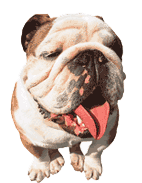Information on Dental Care for Dogs

Other preventive measures include providing dogs with toys and treats that have a tartar-removing effect. These include hard rubber chew toys with hollow interiors that can be stuffed with treats, as well as rope or sheepskin toys, which have fibers that help keep teeth clean.
Periodontal Disease
If a dogs teeth aren’t cared for, the result is sure to be periodontal disease, the most common dental condition affecting dogs. Periodontal disease is the inflammation and infection of the gums and supporting tissues of the teeth. It begins when bacteria-laden plaque and tartar (calculus) build up on teeth, especially below the gum line. Pockets form under the gum line and food lodges in the pockets. These bits of food that remain on teeth are breeding grounds for bacteria. The resulting infection causes bad breath, bleeding and inflammation of the gums, receding gums, loosening of teeth, and eventual tooth loss.
According to the American Veterinary Dental Society, more than 80 percent of dogs over the age of three years develop gum or periodontal disease. Any dog can develop periodontal disease, but its seen most commonly in toy breeds. They have the same number of teeth (42) as larger dogs, but the teeth are crowded into a smaller area. Regular brushing is the best way to get rid of food residue so it doesn’t harden and form the ugly brown deposits known as tartar.
Routine periodontal treatment performed by a veterinarian typically includes ultrasonic scaling, subgingival manual scaling, and polishing. For advanced cases of periodontal disease, some dental specialists use antibiotic therapy, which involves cleaning and polishing the teeth, regular home brushing, and administering antibiotics for the first five days of every month. This regimen decreases the progression of the disease. Another new treatment is Doxyrobe, a gel placed inside the socket to sterilize it. This sustained-release form of doxycycline is used in periodontal pockets to increase attachment. If the dogs teeth are in really bad shape, periodontal surgery such as bone grafting and guided tissue regeneration can be performed. For the most severe cases, extraction is the only option.
Endodontic Conditions
These conditions involve broken or abscessed teeth that require root canals or extractions. Endodontic problems are most common in large dogs, especially shepherd and retriever breeds. These dogs chew a lot on such things as fences, cow hooves, and bones, wearing their teeth down and sometimes breaking them. Even chewing on ice cubes can cause teeth to fracture.
Dental fractures are common in dogs, and treatment is a must if the pulp, the soft tissue that fills the center of a tooth, is exposed. This is not only painful, but it can also lead to tissue death and abscess. A root canal is the preferred method of treatment for such cases, although occasionally extraction may be the best choice.
Don’t ignore a broken tooth, even if it doesn’t seem to bother the dog. The majority of dogs are happier and more active once a tooth repair is made.
Oral Surgery
Oral surgery is done usually to remove teeth or repair fractured jaws. Extractions are performed with minimal pain and discomfort, and jaw fractures can be repaired using new techniques that minimize damage to teeth and ensure a rapid return to normal function.
Dogs may also need oral surgery when they’re diagnosed with tumors of the mouth and throat, which are common in dogs. Radiotherapy and recently developed surgical techniques for removing oral tumors are now available. These techniques often give excellent results, both in terms of cosmetic appearance and prognosis, provided they are applied at an early stage of the disease.
Examine your dogs mouth monthly. Oral tumors can go unnoticed until they’ve reached an advanced stage of development, making successful treatment more difficult. Bring any suspicious swellings or persistent sores to the attention of your veterinarian. Besides oral tumors, dogs can also develop noncancerous masses and swellings such as gingival hyperplasia.





